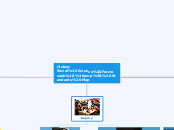History-Social Science Framework & Standards Map
Citizenship
Content Standard 11.1 Students analyze the significant events in the founding of the nation and its attempts to realize the philosophy of government described in the Declaration of Independence.
Content Standard 11.1.1 Describe the Enlightenment and the rise of democratic ideas as the context in which the nation was founded.
Content Standard 11.1.2. Analyze the ideological origins of the American Revolution, the Founding Fathers’ philosophy of divinely bestowed unalienable natural rights, the debates on the drafting and ratification of the Constitution, and the addition of the Bill of Rights.
Content Standard 11.1.3.Understand the history of the Constitution after 1787 with emphasis on federal versus state authority and growing democratization.
Content Standard 11.1.4 Examine the effects of the Civil War and Reconstruction and of the industrial revolution,
including demographic shifts and the emergence in the late nineteenth century of the United States as a world power.
Litereacy
California Common Core Standards for Writing
CCSS.ELA-Literacy.WHST. 11-12.2. Write informative/explanatory texts, including the
narration of historical events, scientific procedures/ experiments, or technical processes. (B) Develop the topic thoroughly by selecting the most significant and relevant facts, extended definitions, concrete details, quotations, or other information and examples appropriate to the audience’s knowledge of the topic.
CCSS.ELA-Literacy.WHST. 11-12.6. Use technology, including the Internet, to produce,
publish, and update individual or shared writing
products in response to ongoing feedback, including
new arguments or information.
California Common Core Standards for Reading
CCSS.ELA-Literacy.RH. 11-12.2. Determine the central ideas or information of a primary or secondary source; provide and accurate summary that makes clear the relationships among the key details and ideas.
CCSS.ELA-Literacy.RH. 11-12.3. Evaluate various explanations for actions or events and determine which explanation best accords with textual evidence, acknowledging where the text leaves matters uncertain.
CCSS.ELA-Literacy.RH. 11-12.9. Integrate information from diverse sources, both primary and secondary, into a coherent
understanding of an idea or event, noting
discrepancies among sources.
Inquiry
Historical & Social Sciences Analysis Skills
Historical Research, Evidence, and Point of View: 2. Students identify bias and prejudice in historical interpretations.
Historical Interpretation: 4.Students understand the meaning, implication, and impact of historical events and recognize that events could have taken other directions
Chronological and Spatial Thinking: 2.Students analyze how change happens at different rates at different times; understand that some aspects can change while others remain the same; and understand that change is complicated and affects not only technology and politics but also values and beliefs
Historical Research, Evidence, and Point of View: 1. Students distinguish valid arguments from fallacious arguments in historical interpretations.
Historical Interpretation: 1. Students show the connections, causal and otherwise, between particular historical
events and larger social, economic, and political trends and developments.
California Content Standard
Content Standard 11.3.3. Cite incidences of religious intolerance in the United States (e.g., persecution of
Mormons, anti-Catholic sentiment, anti-Semitism).
Content Standard 11.3.5. Describe the principles of religious liberty found in the Establishment and Free Exercise clauses of the First Amendment, including the debate on the issue of separation of church and state.
Content Standard 11.4.6. Trace the declining role of Great Britain and the expanding role of the United States
in world affairs after World War II.
Content Standard 11.5.2.Analyze the international and domestic events, interests, and philosophies that prompted attacks on civil liberties, including the Palmer Raids, Marcus Garvey’s “back-to-Africa” movement, the Ku Klux Klan, and immigration quotas and the responses of organizations such as the American Civil Liberties Union, the National Association for the Advancement of Colored People, and the Anti-Defamation League to those attacks.
Content Standard 11.5.6 Trace the growth and effects of radio and movies and their role in the worldwide diffusion of popular culture.
Content
Economics
11.8 Students analyze the economic boom and social transformation of post–World War II America.
11.8.2 Describe the significance of Mexican immigration and its relationship to the agricultural economy, especially in California.
11.8.4 Analyze new federal government spending on defense, welfare, interest on the national debt, and federal and state spending on education, including the California Master Plan.
11.8.7 Describe the effects on society and the economy of technological developments since 1945, including the computer revolution, changes in communication, advances in
medicine, and improvements in agricultural technology.
Geography
11.2 Students analyze the relationship among the rise of industrialization, large scale rural-to-urban migration, and massive immigration from Southern and Eastern Europe.
11.2.2 Describe the changing landscape, including the growth of cities linked by industry and trade, and the development of cities divided according to race, ethnicity, and class.
11.2.3 Trace the effect of the Americanization movement.
11.2.6 Trace the economic development of the United States and its emergence as a major industrial power, including its gains from trade and the advantages of its physical geography.
History
11.7 Students analyze America’s participation in World War II
11.7.1 Examine the origins of American involvement in the war, with an emphasis on the events that precipitated the attack on Pearl Harbor.
11.7.3 Identify the roles and sacrifices of individual American soldiers, as well as the unique contributions of the special fighting forces (e.g., the Tuskegee Airmen, the
442nd Regimental Combat team, the Navajo Code Talkers).
11.7.7 Discuss the decision to drop atomic bombs and the consequences of the decision (Hiroshima and Nagasaki).









